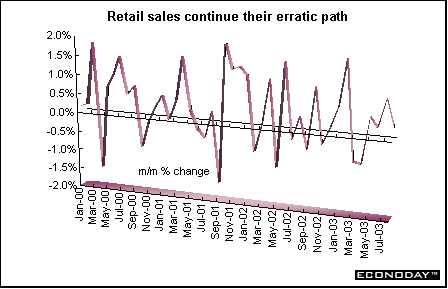
Indicator scoreboard
EMU - August seasonally adjusted merchandise trade surplus with the rest of the world was €6.9 percent, down from July's €7.5 billion surplus. Exports were up 2.8 percent while imports increased 3.8 percent. When compared with last year, both exports and imports are down, 6.1 percent and 3.8 percent respectively.

Germany - August seasonally adjusted industrial production was revised to a decline of 3.7 percent from the originally reported decline of 2.5 percent. Industrial production was affected by a larger-than-usual number of summer holidays in August compared to previous years. Industrial production excluding construction - the figure used by Eurostat to calculate eurozone industrial output - was revised to a drop of 3.7 percent, down significantly from the originally reported decrease of 2.1 percent. All categories were revised downward with the exception of construction.

August manufacturing orders were revised to an increase of 0.1 percent from the originally reported increase of 0.6 percent. Both foreign and domestic orders were revised down. Foreign orders were up 2.1 percent instead of the originally reported 2.4 percent increase. Domestic orders were revised to a decline of 1.6 percent from the originally reported drop of 1.0 percent. Orders are down 1.3 percent on the year.
September producer prices were unchanged but were up 1.9 percent when compared with last year. Excluding energy, the PPI was up 0.1 percent and 0.4 percent on the year. The statistics office said that beginning with next month's release, the base year will change from 1995 to 2000.

France - September seasonally and calendar adjusted consumer spending on manufactured goods jumped 3.4 percent and was up 3.9 percent when compared with last year. Sales soared after the August heat wave kept shoppers at home. Clothing sales were up 4.4 percent after plummeting 9 percent in August. Household durables were up 3.0 percent after dropping 1.2 percent in the previous month.

Britain - September retail sales volumes were up 0.6 percent and 3.9 percent when compared with last year thanks to strong clothing and footwear sales. Food sales slipped while non-food store sales were up.

Third quarter gross domestic product was up 0.6 percent and 1.9 percent when compared with last year. Production industry output was unchanged but was down 0.4 percent on the year. Manufacturing output inched up but mining and energy declined. Services jumped 0.7 percent on the quarter.

Asia
Japan - September seasonally adjusted merchandise trade surplus jumped 8.9 percent to ¥986.1 billion ($9.1 billion). Exports grew 3.4 percent and imports climbed 2 percent. The surplus was the highest since June 2000. Exporters are benefiting from accelerating growth in the U.S. and China, Japan's two biggest overseas markets. Trade with China, where Japanese companies such as Sony Corp. have built factories, rose to a record last month from a year earlier. Exports to China soared 42 percent while imports jumped 21 percent.

August seasonally adjusted tertiary activity index was up 1.0 percent after plummeting 2.4 percent in July. The index was up 0.2 percent on the year. Transport and communication, wholesale and retail trade, electricity and related industries and finance & insurance contributed to the increase. Services and real estate declined. The all industry index was up 0.3 percent. The all industry index takes a reading of activity in the six industries that comprise the tertiary index combined with activity in the construction, agricultural and fisheries industries, the public sector and industrial output. This index is considered a close approximation for gross domestic product growth as measured by industrial and service sector output.

Americas
Canada - September consumer price index was up 0.2 percent and 2.2 percent when compared with last year. An 8.1 percent increase in tuition fees fueled the increase. However, seasonal fresh food prices dropped 10.8 percent. Excluding food and energy, the CPI was up 0.3 percent and 1.9 percent on the year. The Bank of Canada CPI, which excludes eight volatile components, was up 0.3 percent and 1.7 percent on the year.

August retail sales were up 0.3 percent and 3.9 percent when compared with last year. General merchandise, food and furniture sales were up. Excluding motor and recreational vehicle sales, the largest part of the automotive sector, retail sales increased 0.9 percent. Motor and recreational vehicle sales fell 1.3 percent after jumping 4.2 percent in July. Higher gasoline prices contributed to a 5.5 percent jump in gasoline service station sales.



Last Week's Highlights • Global
Stock Market Indexes • Recap of Global Markets
• Currencies • Indicator
Scoreboard

The Bottom Line •
Looking Ahead
|